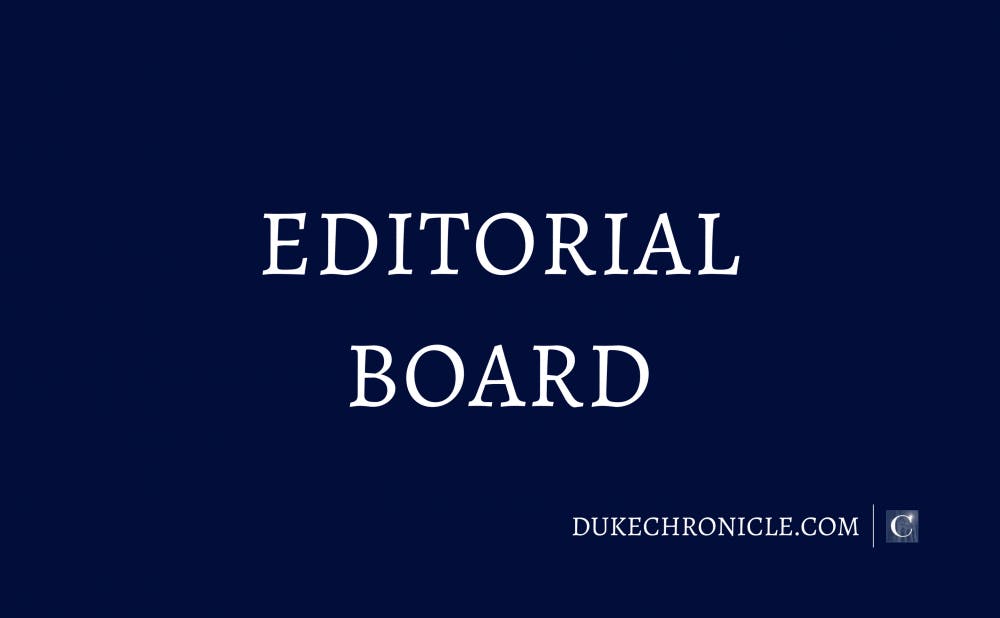Despite the majority of undergraduates spending the past week on brief reprieve from campus, Duke still managed to make local news headlines over Thanksgiving break. On Friday, students found multiple stickers and flyers on West Campus bearing the logo of Identity Evropa, a neo-Nazi and white supremacist organization that targets college-aged white men for recruitment. This comes after a semester’s worth of white supremacist hate speech incidents—vandalism of Mary Lou Center, pumpkins carved with swastikas, ‘It’s okay to be white’ flyers on East Campus and a swastika painted over the Pittsburgh shooting mural—which have averaged out to nearly one every three weeks.
It’s a familiar repertoire now for most in the Duke community. The cycle begins with someone finding or seeing vandalism or targeted acts of hate. Following that, the Chronicle reports on it and the story rapidly gains attention across campus. When students express outrage and demand change or an appropriate response from university leadership, we are often met with a pithy, toothless reply from administration. Once it becomes clear no tangible reforms will take place, students eventually are forced to return to problem sets or essays in Perkins. Rinse and repeat.
However, the most recent incidents have spurred a twist to this now-familiar series of unfortunate events. President Price announced plans to install security cameras at the East Campus bridge and increase security presence at the Freeman Center for Jewish Life after someone painted a swastika over an East Campus bridge mural memorializing the Pittsburgh shooting.
While this certainly deviates from the usual modus operandi of emails with ultimately meaningless platitudes, Price’s reaction deserves further scrutiny.
It appears dubious at best that security cameras will actually accomplish anything and not simply end up as another momentary solvent to an outsized crisis. If a future vandal were a student and was identified by the surveillance, what would the consequences be without a robust hate and bias policy? Would the student actually face consequences or would it fade away á la the Snapchat incident from spring 2018? If the perpetrator had no Duke affiliation, is there any jurisdiction for the University over the case? Would Duke pursue legal action? Once again, Duke’s chronic lack of transparency obscures the protocol for potential future incidents.
Furthermore, this newly announced reactive measure calls for critical analysis given the complicated and violent history of surveillance on a national and university level. On campus, Duke Alerts sent out by the Duke University Police Department (DUPD) are perfect examples of dangerous policing methods currently in place. Wide-spread notifications about suspects are based off of eyewitness testimony—a notoriously unreliable method of identification—and include estimated race and gender. Suddenly everyone fitting the meager profile is a surveilled threat. Suddenly everyone fitting the meager profile is a surveilled threat. This tactic can be especially dangerous for black members of the Duke community who, statistically, already face elevated risk for violence from police and—as a result of rampant anti-black racism—are perceived as more threatening than white counterparts.
One need not look far for documented cases of black students becoming targets of racial profiling by campus security. Earlier this year, a Yale University graduate student was confronted by police for napping in her dorm common room. On a national level, there have been multiple rigorous studies disproving the validity of practices like “broken windows” policing and “community policing.” It’s clear that increased police presence and surveillance does not mean more safety for our communities. What it entails is the racialized management, alienation and brutalization of people of color, particularly Black and Brown people.
As this semester comes to an end, it is all too clear that elite institutions like ours are not immune or indifferent to white supremacy. Rather, they are prime breeding grounds and active facilitators for white supremacy to flourish without much hinderance other than the occasional student protests that go in and out of administrators’ ears. Pressure is mounting to recognize that these racist ideologies festering on campus aren’t merely differences of opinion; they are the expression of the insidious forces of racism, classism and sexism that undergird our society.
What will the university do to be proactive rather than reactive? When will they raise the bar of the bare minimum and build around safety, not security?
The Chronicle’s editorial board is made up of student members from across the University and is independent.
Get The Chronicle straight to your inbox
Signup for our weekly newsletter. Cancel at any time.

